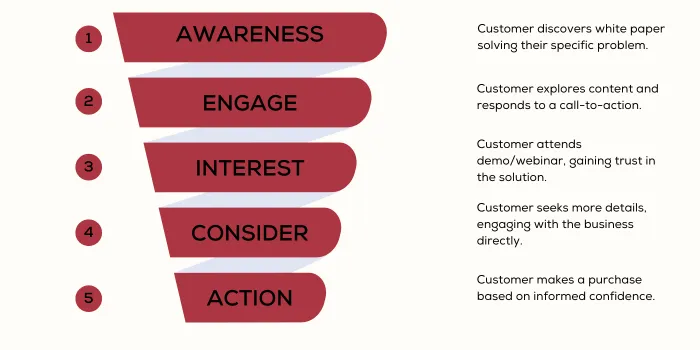

Why do businesses need white papers in an age of instant communication? Because in a world overwhelmed by quick fixes and surface-level solutions, decision-makers crave deep, trustworthy insights that can guide their most crucial choices.
These documents fill the vital gap between superficial marketing content and dense academic research. If that is not all, nine out of 10 digital marketers recommend white paper as a crucial component for ICO success.
Let’s explore the different facets of whitepapers in this blog.
What exactly is a white paper?
White papers are sophisticated business documents that transform complex information into actionable insights. Unlike case studies or basic research documents, they dig deeper, examining industry-wide challenges and presenting comprehensive solutions. They serve as powerful tools for establishing thought leadership, guiding major decisions, and building lasting business relationships.
What started as a way for government officials to explain policies has transformed into an essential business tool. White papers have come a long way from their origins in the British Parliament.
Today, they serve as trusted guides for business leaders, helping them navigate challenging decisions and understand emerging opportunities.

White papers offer something different - depth, credibility, and practical solutions in a world drowning in information. They go beyond surface-level marketing to provide real value, helping readers understand complex issues and make informed decisions.
This depth sets them apart from other business documents and makes them particularly valuable for organizations dealing with sophisticated products or services.
Here are a few reasons why white papers still matter in the business world:
White papers are unique compared to other business documents like reports, memos, or brochures.
In short, while other business documents are great for quick communication or marketing, white papers are powerful tools for sharing knowledge, building credibility, and influencing key decisions.

The process starts with choosing the right topic—one that matters to the target audience and matches the organization's expertise. The writing needs to strike a balance between authoritative and accessible, avoiding unnecessary complexity while maintaining professional depth.
The key components of a white paper include:
A white paper follows a structured format to present information clearly and persuasively. Here’s a detailed explanation of its components:
The cover page is the first impression of your white paper. It includes the title, your company name, and logo. Sometimes, it may also include a subtitle or tagline. The goal is to make it look professional and inviting while giving readers a hint about the content.
This is a brief, personal note addressed to the reader, often written by someone like the CEO or a subject matter expert. It introduces the white paper, expresses gratitude for reading, and highlights why the topic is important. Though optional, it adds a warm and professional touch.
The abstract acts as a summary of the white paper. In just a few sentences, it tells readers what the document is about, including the problem being addressed, the solution offered, and the key benefits. It helps busy readers quickly decide if the white paper is relevant to them.
This is the main content and is divided into specific sections:

A well-crafted white paper follows a clear structure that helps readers grasp complex ideas. It starts with a clear overview of the challenge, builds through careful analysis, and leads to practical recommendations. Each section builds on the previous one, creating a logical path to understanding.
Here are some key tips for writing an outstanding white paper:
Understanding how well a white paper performs helps organizations improve future efforts. These insights help organizations refine their approach over time.
Here are key metrics to measure white paper success:

Here are some key factors that can be incorporated into your white paper to make it appealing to the modern readers:
LexiConn can help you with a team of expert writers who excel in white paper writing. Creating effective white papers requires the skill and experience that not every writing team possesses.
The team at LexiConn has writers who know exactly how to research, structure, and write white papers that get results. These writers understand business needs and can turn complex ideas into clear, engaging papers that help companies build trust with their readers.
Share your brief for white paper here.
White papers continue to evolve with changing business needs and technology. Interactive elements, personalized content, and new formats are emerging. However, the core purpose remains the same - helping readers understand complex issues and make better decisions.
Organizations that regularly produce high-quality white papers often develop a culture of knowledge sharing. This culture helps them stay ahead of industry trends and maintain strong connections with their market.
The value of white papers depends on maintaining high standards of accuracy and objectivity. This means careful fact-checking, thorough research, and honest analysis. Cutting corners in these areas can damage not just the document but the organization's reputation.
The true measure of a white paper's success lies in its impact on readers' thinking and decisions. This impact often extends beyond immediate business results to shape industry conversations and approaches to common challenges.
In a business world that increasingly values expertise and insight, well-crafted white papers remain powerful tools for sharing knowledge and influencing decisions. Their ability to combine deep insight with practical guidance makes them particularly valuable for organizations dealing with complex products, services, or ideas.
The key to success lies in maintaining focus on reader value while adapting to changing communication needs and preferences. Organizations that master this balance find that white papers become valuable assets in building their market position and relationships with key decision-makers.
As business challenges become more complex, the need for clear, thoughtful analysis and guidance grows stronger. White papers that meet this need with well-researched, clearly presented insights will continue to play an important role in business communication and decision-making.
Interested to write a compelling white paper for your business? Visit our website or drop us a line at [email protected].



I have read and accept the Privacy Policy
Read More